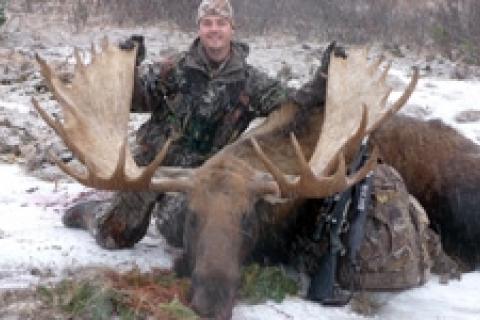
Moose are the largest member of the deer family, and a big bull is one of the most impressive trophies in the hunting world. As with most big game animals, field judging moose is very difficult, especially if you need to make a hurried decision. So if you've got your sights set on putting a bull moose, and your name, into the record books, here's what you need to know.
 |
| Many hunters tend to judge moose on antler spread alone, but there's more to factor in. Photo courtesy of "Canada in the Rough" |
Many hunters tend to judge moose on antler spread alone, but both of the major records keepers for North American big game, the Boone and Crockett Club and Safari Club International also factor in the length or height of each palm, the width of each palm, the points on each antler and the circumference at the base of each antler (each organization uses slightly different scoring systems, however). Although many hunters see the spread of a bull's antlers as being the most desirable characteristic, this measurement is only counted once and it is not the most important when it comes to its score. In terms of overall contribution to the animal's final score, it is palm length and width that really pile up the scoring points. Look for high, broad and generally well-developed antlers. Here are some tips to help when you don't have a tape measure handy. (Note that these organizations also have differing boundaries for the various moose sub-species classifications, with differing minimum scores for qualification.)
When viewed from the side, look for the tips of the top palms to reach back nearly to the hump on the bull's back, and the tips of the brow points to reach at least half-way down the bridge of his nose. Then look for palmation between these front points, rather than just two or three long spikes, as this feature can sometimes add up to 10 inches in length per side.
Of course, outside spread is still very desirable, with a minimum of 50 inches being the goal for a record book animal, and 60 inches is the Holy Grail for moose anywhere. A full frontal view with the animal's head down and antlers nearly vertical, although not always available under field conditions, gives the best chance for accurate evaluation of this. When given such a view, look for at least 10 inches of open space between the bull's body and the inner edges of his palms. If you can see only the bull's head and not his body, then use the bull's ears as a guide. A mature bull's ears are roughly 30 inches from tip to tip, with the ears themselves being 9 to 10 inches long. If the bull you are looking at seems to have an extra ear length of antler spread on either side, he likely has a 50-inch spread. Keep in mind as well that the outside spread is measured to the tips of the widest points on the outside edges of the palms, at a right angle to the inner edge of the palm, so one exceptionally long point on each edge can help a lot in this regard.
This ear gauge is also useful in estimating the width of each palm. If a bull's palms are at least as wide as his ears are long, he'll have at least 10-inch wide palms, which is about the minimum for a record book bull.
These methods of estimating are useful, but be warned that the body size of bulls can vary and make judging antlers deceiving, as a big-bodied bull can look to have weak antlers, when the opposite is true, and the reverse applies to small-bodied bulls.
It's really not just one single attribute that a moose rack must have that will make it stand out above the rest, and very few bulls will have all of these attributes. But they are out there. If you do find one that has a number of these qualities, you may have found yourself a bull for the books.
Good hunting.
- 17676 views

